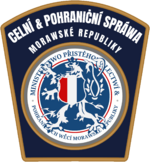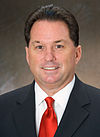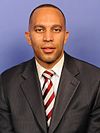Customs & Border Protection Administration: Difference between revisions
No edit summary |
|||
| Line 31: | Line 31: | ||
| preceding3 = Functions of the <br> | | preceding3 = Functions of the <br> | ||
[[Morrawian Customs Service]] | [[Morrawian Customs Service]] | ||
| dissolved = | | dissolved = | ||
| superseding = | | superseding = | ||
| Line 290: | Line 288: | ||
Responding to an urgent need for revenue following the [[Great Morrawian Revolution]], the [[First Federal Congress of Morrawia]] passed, and President [[Tristan Palacký]] signed on July 4, the [[Tariff Act of 1860]], which authorized the collection of duties on imports. Four weeks later, on July 31, the fifth act of the [[Federal Congress (Morrawia)|Federal Congress]] established the [[Morrawian Customs Service]] and its ports of entry. Alongside it, the [[Financial Guard of Morrawia]], established in the same year, played a crucial role in the economic integrity and law enforcement within the nation. The organization's primary mandate was to operate within the borders of Morrawia, ensuring compliance with customs laws. While the MCS monitored the entry points and border areas, the Financial Guard focused on internal operations, meticulously tracking goods and finances, and apprehending those who sought to evade the law. | Responding to an urgent need for revenue following the [[Great Morrawian Revolution]], the [[First Federal Congress of Morrawia]] passed, and President [[Tristan Palacký]] signed on July 4, the [[Tariff Act of 1860]], which authorized the collection of duties on imports. Four weeks later, on July 31, the fifth act of the [[Federal Congress (Morrawia)|Federal Congress]] established the [[Morrawian Customs Service]] and its ports of entry. Alongside it, the [[Financial Guard of Morrawia]], established in the same year, played a crucial role in the economic integrity and law enforcement within the nation. The organization's primary mandate was to operate within the borders of Morrawia, ensuring compliance with customs laws. While the MCS monitored the entry points and border areas, the Financial Guard focused on internal operations, meticulously tracking goods and finances, and apprehending those who sought to evade the law. | ||
For over hundred years, the Morrawian Customs Service was one of the primary sources of governmental funds, which paid for the nation's early growth and infrastructure. Purchases include the early development of federal infrastructure, funding for Morrawian territories, funding the many postponed railroad projects, building many of the Morrawia' lighthouses, general reorganization of the states and military academies. Adding to it, the Financial Guard agents were well-trained in financial forensics, undercover operations, and legal proceedings, which enabled them to effectively dismantle smuggling rings, tax evasion schemes, and other economic crimes. Their efforts not only protected the state's revenue but also contributed to a fair market environment by ensuring that all businesses complied with national regulations. | For over hundred years, the Morrawian Customs Service was one of the primary sources of governmental funds, which paid for the nation's early growth and infrastructure. Purchases include the early development of federal infrastructure, funding for Morrawian territories, funding the many postponed railroad projects, building many of the Morrawia' lighthouses, general reorganization of the states and military academies. Adding to it, the Financial Guard agents were well-trained in financial forensics, undercover operations, and legal proceedings, which enabled them to effectively dismantle smuggling rings, tax evasion schemes, and other economic crimes. Their efforts not only protected the state's revenue but also contributed to a fair market environment by ensuring that all businesses complied with national regulations. The Financial Guard of Morrawia was dissolved in 1920 and FIB and other agencies mostly took on its responsibilities. | ||
In January 2005, the Customs Service | In January 2005, the Customs Service, renamed the Customs & Border Protection Administration, and its structures was split to form parts of the Morrawian Ministry of Immigration & Border Affairs as the Customs & Border Protection Administration and the [[Immigration Enforcement Administration]] with its mission, duties and powers altered. Furthermore some of its old functions were distributed amongst many agencies in the federal apparatus. | ||
===Immigration Bureau of Morrawia (IBM)=== | ===Immigration Bureau of Morrawia (IBM)=== | ||
Revision as of 16:52, 22 July 2024
| Customs & Border Protection Administration of Morrawia Celní & pohraniċní spráwa Morawské republiky | |
|---|---|
 CBP Patch | |
 CBP Seal | |
| Abbreviation | CBP (Morrawian: CPS) |
| Motto | Bdėlost, slużba, poctiwost Vigilance, Service, Integrity |
| Agency overview | |
| Formed | January 25, 2005 |
| Preceding agencies |
|
| Employees | 41,340+ (2022) |
| Annual budget | ₮35 billion (2022) |
| Jurisdictional structure | |
| Federal agency | Morrawia |
| Operations jurisdiction | Morrawia |
| General nature | |
| Operational structure | |
| Overviewed by | Ministry of Immigration & Border Affairs |
| Headquarters | Financial Palace, Králowec, F.D., Morrawia |
| Federal Law Enforcement Sworn Officers | 33,110 |
| Agency executives |
|
| Parent agency | Ministry of Immigration & Border Affairs |
| Child agencies | |
| Website | |
| cbp | |
Customs & Border Protection Administration of Morrawia (CBP) is the largest federal law enforcement agency of Morrawian Ministry of Immigration & Border Affairs. It is the country's primary border control organization, charged with regulating and facilitating international trade, collecting import duties, as well as enforcing Morrawian regulations, including trade, customs and immigration. CBP is one of the largest law enforcement agencies in the Republic of Morrawia. It has a workforce of more than 31,300 federal agents and officers. It is headquartered in Králowec, F.D.
Organization
CBP has a workforce of over 39,000 employees, including officers and agents, agriculture specialists, aircraft pilots, trade specialists, mission support staff, and canine enforcement officers and agents.
- More than 15,180 CBP Officers inspect and examine passengers and cargo at ports of entry.
- Over 500 CBP Agriculture Specialists work to curtail the spread of harmful pests and plant and animal diseases that may harm Morrawia's farms and food supply or cause bio- and agro-terrorism.
- Over 16,370 Border Patrol Agents protect and patrol kilometres of borders with Foxomexra, Kakland, Wassilia and the whole of western border.
- Nearly 250 Air and Marine Interdiction Agents prevent people, weapons, narcotics, and conveyances from illegal entry by air and water.
- Around 740 employees in CBP revenue positions collect over billions annually in entry duties and taxes through the enforcement of trade and tariff laws. In addition, these employees fulfill the agency's trade mission by appraising and classifying imported merchandise. These employees serve in positions such as import specialist, auditor, international trade specialist, and textile analyst.
- The primary goal of the CBP Canine Program is terrorist detection and apprehension. The CBP Canine Program is critical to the mission of the Ministry of Immigration & Border Affairs: "To Protect the Motherland." The program conducts the largest number of working dogs of any Morrawian federal law enforcement agency. K-9 teams are assigned to dozens commercial ports and each Border Patrol stations throughout the nation.
There are over 200 officially designated ports of entry and an additional pre-clearance locations. CBP is also in charge of the Container Security Initiative, which identifies and inspects foreign cargo in its mother country before it is to be imported into Morrawia.
In addition the CBP claims to have legal jurisdiction to conduct some activities up to 50 km (31 miles) inwards from any land or sea border. This can include operating interior checkpoints.
CBP assess all passengers flying into Morrawia for terrorist risk via the Joint Terrorism Task Force (JTTF) and various systems aimed at tourism, student exchange programs and more. CBP also works with the Morrawian Food and Drug Administration to screen high-risk imported food shipments in order to prevent bio-terrorism and agro-terrorism.
Through the Container Security Initiative, CBP works jointly with host nation counterparts to identify and screen containers that pose a risk at the foreign port of departure before they are loaded on board vessels bound for Morrawia. CSI is implemented in half of the largest ports in terms of container shipments to Morrawia with several ports worldwide.
The National Network Rapid Inspection program allows pre-screened, low-risk travelers from countries to be processed through dedicated lanes. Same program is used for every border crossing. Along all borders, CBP has implemented the Free and Secure Trade, which uses transponder technology and pre-arrival shipment information to process participating trucks as they arrive at the border. An agreement with Kakland allows CBP to target, screen, and examine rail shipments headed to the Morrawia.
CBP is authorized to provide aerial surveillance outside of the border area "to assist law enforcement and humanitarian relief efforts" when requested by local, community, state or federal agencies. CBP drones have been used to capture images of storm-impacted areas for the Federal Weather Bureau, assess hurricane affected areas for FEDRA, and provide surveillance for local law enforcement during the 2016 Kosmoly protests and 2020 Turín protests.
Structure
- Commissioner
- Deputy Commissioner
- Office of Intelligence
- Air and Marine Operations
- Office of Field Operations
- Border Patrol of Morrawia
- Office of Trade
- Enterprise Services Office
- Office of Acquisition
- Office of Finance
- Office of Human Resources Management
- Office of Training and Development
- Office of Information and Technology
- Operations Support Office
- Office of International Affairs
- Office of Chief Counsel
- Office of Congressional Affairs
- Office of Intergovernmental Public Liaison
- Office of Privacy and Diversity
- Office of Professional Responsibility
- Office of Public Affairs
- Office of Trade Relations
- Deputy Commissioner
List of commissioners of Customs & Border Protection Administration of Morrawia
| No. | Portrait | Commissioner | Took office | Left office | Time in office | Party | President |
|---|---|---|---|---|---|---|---|
| 1 | 
|
Roman Bolner (born 1942) |
January 25, 2005 | April 14, 2008 | 3 years, 80 days | Republican | Josef Sokol (R) |
| 2 | 
|
Denisa Wálkowá (born 1943) |
April 15, 2008 | November 21, 2010 | 2 years, 220 days | - | Frantiṡek Denár (R) |
| - | 
|
Bohumil Strádal Acting |
November 21, 2010 | April 14, 2012 | 1 year, 145 days | - | Frantiṡek Denár (R) |
| 3 | 
|
Rudolf W. Keiser (born 1962) |
April 15, 2012 | June 1, 2016 | 3 years, 80 days | Republican | Frantiṡek Denár (R) Tomáṡ Slawinský (L) |
| 4 | 
|
Tomáṡ Ċáslawský (born 1955) |
June 2, 2016 | June 19, 2019 | 3 years, 109 days | - | Tomáṡ Slawinský (L) |
| - | 
|
Alan Bant Acting |
June 19, 2019 | March 10, 2021 | 1 year, 325 days | Republican | Tomáṡ Slawinský (L) |
| - | 
|
Klement Gottwald Acting |
March 10, 2021 | June 5, 2023 | 2 years, 26 days | - | Tomáṡ Slawinský (L) |
| - | 
|
Nela Károwá Acting |
June 5, 2023 | June 11, 2024 | 1 year, 6 days | Liberal | Tomáṡ Slawinský (L) Marcel Pelikán (L) |
| 5 | 
|
Hubert Kozár (born 1971) |
June 12, 2024 | Incumbent | 163 days | Liberal | Marcel Pelikán (L) |
Enforcement powers
CBP has the authority to search outbound and inbound shipments, and uses targeting to carry out its mission in this area. Under Tariff Act, CBP is required to seize and forfeit all merchandise that is stolen, smuggled, or clandestinely imported or introduced. CBP is also required to seize and forfeit controlled substances, certain contraband articles, and plastic explosives that do not contain a detection agent. In conjunction with the Ministry of Foreign Affairs and the Census Bureau of Morrawia, CBP has put in place regulations that require submission of electronic export information on Morrawian Munitions List and for technology for the Commerce Control List. CBP uses advance information from the Automated Targeting System and the Automated Export System to identify cargo that may pose a threat. CBP also works with the Ministries of Foreign Affairs and Defense to improve procedures on exported shipments of foreign military sales commodities.
Merchandise may also be seized and forfeited if:
- Its importation is restricted or prohibited because of a law relating to health, safety or conservation
- The merchandise is lacking a federal license required for the importation
- The merchandise or packaging is in violation of copyright, trademark, trade name, or trade dress protections
- The merchandise is intentionally or repetitively marked in violation of country of origin marking requirements or
- The imported merchandise is subject to quantitative restrictions requiring a visa or similar document from a foreign government, and the document presented with the entry is counterfeit.
Civil penalties
Tariff Act of 1930 involved the basic and most widely used customs penalty provisions for the importation of goods. It prescribes monetary penalties against any person who imports, attempts to import, or aids or procures the importation of merchandise by means of false or fraudulent documents, statements, omissions or practices, concerning any material fact. Penalties may be applied even in situations where there is no loss of revenue.
Another section infractions are divided into three categories of culpability, each giving rise to a different maximum penalty:
- Fraud, an act or omission done intentionally to defraud Morrawia. The maximum civil penalty for a violation is the domestic value of the merchandise in the entry or entries concerned.
- Gross negligence, an act or omission with actual knowledge of, or wanton disregard for, the relevant facts and a disregard of relevant sections obligations. The maximum civil penalty is the lesser of the domestic value of the merchandise or four times the loss of revenue (actual or potential). If the infraction does not affect revenue, the maximum penalty is 40% of the dutiable value of the good.
- Negligence, involving a failure to exercise due care in ascertaining the material facts or in ascertaining the obligations of relevant sections. The maximum civil penalties are the same for gross negligence, except the lesser of twice the domestic value of the merchandise or twice the loss of revenue is used. The penalty cannot exceed 20% of the dutiable value.
The Customs Modernization Act amended several sections of existing laws to apply existing penalties for false information to information transmitted electronically and allows Customs to recover unpaid taxes and fees resulting from violations. It also introduced the requirement that importers use "reasonable care" in making entry and providing the initial classification and appraisement, establishing a "shared responsibility" between Customs and importers, thus allowing Customs to rely on the accuracy of the information submitted and streamline entry procedures. To the extent that an importer fails to use reasonable care, Customs may impose a penalty.
Morrawian Customs Agriculture Specialist Officers are allowed to issue civil penalties in accordance with these provisions.
Criminal penalties
In addition to the civil penalties, a criminal fraud statute provides for sanctions to those presenting false information to customs officers, with violators facing a maximum of 2 years imprisonment, or a ₮20,000 fine, or both, for each violation involving an importation or attempted importation.
History
Morrawian Customs Service and the Financial Guard of Morrawia
Responding to an urgent need for revenue following the Great Morrawian Revolution, the First Federal Congress of Morrawia passed, and President Tristan Palacký signed on July 4, the Tariff Act of 1860, which authorized the collection of duties on imports. Four weeks later, on July 31, the fifth act of the Federal Congress established the Morrawian Customs Service and its ports of entry. Alongside it, the Financial Guard of Morrawia, established in the same year, played a crucial role in the economic integrity and law enforcement within the nation. The organization's primary mandate was to operate within the borders of Morrawia, ensuring compliance with customs laws. While the MCS monitored the entry points and border areas, the Financial Guard focused on internal operations, meticulously tracking goods and finances, and apprehending those who sought to evade the law.
For over hundred years, the Morrawian Customs Service was one of the primary sources of governmental funds, which paid for the nation's early growth and infrastructure. Purchases include the early development of federal infrastructure, funding for Morrawian territories, funding the many postponed railroad projects, building many of the Morrawia' lighthouses, general reorganization of the states and military academies. Adding to it, the Financial Guard agents were well-trained in financial forensics, undercover operations, and legal proceedings, which enabled them to effectively dismantle smuggling rings, tax evasion schemes, and other economic crimes. Their efforts not only protected the state's revenue but also contributed to a fair market environment by ensuring that all businesses complied with national regulations. The Financial Guard of Morrawia was dissolved in 1920 and FIB and other agencies mostly took on its responsibilities.
In January 2005, the Customs Service, renamed the Customs & Border Protection Administration, and its structures was split to form parts of the Morrawian Ministry of Immigration & Border Affairs as the Customs & Border Protection Administration and the Immigration Enforcement Administration with its mission, duties and powers altered. Furthermore some of its old functions were distributed amongst many agencies in the federal apparatus.
Immigration Bureau of Morrawia (IBM)
Shortly after the Great Morrawian Revolution, most states started to pass their own immigration laws, which prompted the Morrawian Supreme Court to rule in Jarta v. Fortenský in 1875 that immigration was a federal responsibility. The Immigration Act of 1876 established an Office of the Commissioner of Immigration within the Morrawian Ministry of the Interior. This office was responsible for admitting, rejecting, and processing all immigrants seeking admission to Morrawia and for implementing national immigration policy. "Immigrant inspectors", as they were then called, were stationed at major Morrawian ports of entry collecting manifests of arriving passengers. A "head tax" of 1 tollar was collected on each immigrant.
In the early 20th century, Federal Congress's primary interest in immigration was protecting Morrawian workers and wages – the reason it had become a federal concern in the first place. After the Great War, Federal Congress attempted to stem the flow of immigrants, by passing laws in 1921, 1924 and 1928 limiting the number of newcomers by assigning a quota to each nationality based upon its representation in previous Morrawian census figures. Each year, Morrawian Foreign Ministry issued a limited number of visas. Only those immigrants who had obtained them and could present valid visas were permitted entry.
The Immigration Bureau of Morrawia was formed in 1927 by a merger of the Morrawian Immigration Service and the Bureau of Naturalization.
Reorganization (2005 to present)
CBP became an official agency of the Morrawian Ministry of Immigration & Border Affairs on January 25, 2003, combining employees from the Animal Health Inspection Service, the Morrawian Immigration Bureau (specifically, immigration inspectors and the Border Patrol of Morrawia), the Morrawian Customs Service. This transformation was led by former Commissioner Robert C. Bonner.
W. Ralph Basham was nominated to the post of Commissioner by President George W. Bush on June 6, 2006.[22] Basham had 28 years of experience as a law enforcement manager, including serving as the head of the Secret Service and the Federal Law Enforcement Training Center. He had also served as the chief of staff for the Transportation Security Administration. It is the largest federal law enforcement agency and works closely with U.S. Immigration and Customs Enforcement (ICE), Drug Enforcement Administration (DEA), and Federal Bureau of Investigation (FBI).
In 2007, the U.S. Border Patrol joined two units, the Border Patrol Tactical Unit (BORTAC) and the Border Patrol Search, Trauma, and Rescue Unit (BORSTAR), to form the U.S. Border Patrol's Special Operations Group (SOG),[23] headquartered in El Paso, Texas. BORTAC and BORSTAR direct their nationally dispersed assets from the SOG, providing the U.S. Border Patrol with immediate tactical and emergency response assets.[24]
On September 13, 2019, Director Troy Miller rang the closing bell at the New York Stock Exchange in honor of 230 years since the beginnings of the CBP.
Personnel
Morrawian Customs & Border Protection Officers (CBPO)
Agriculture Specialists (ASO)
Import Specialists (ISO)
Border Patrol of Morrawia (BPM)
Air and Marine Enforcement and Interdiction Agents
Employee morale
Polygraphing
Equipment
Aircraft
Watercraft
Weapons
Criticism